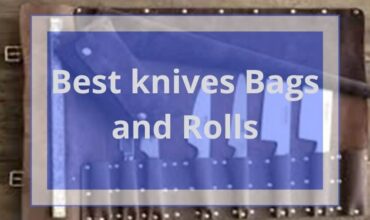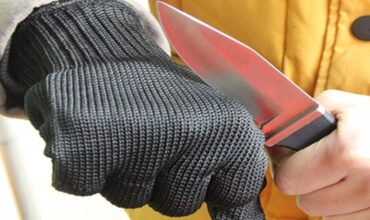Which is better – Staub or Le Creuset Dutch ovens? This is one of the most common questions from home cooks looking to buy their first premium enamelled cast iron pot. Both brands produce exceptional Dutch ovens loved by professional and amateur chefs alike.
While the two share similarities, shoppers should understand some key differences. What sets Staub and Le Creuset apart regarding design, performance and value? The answer may surprise you.
Discover how to choose between these top makers of heirloom-quality pots and find the perfect Dutch oven for your kitchen.
Why So Popular?
Staub and Le Creuset Dutch pots have been kitchen staples for years. Their popularity comes from their top-notch quality and performance.
The enamelled cast iron construction is key. The cast iron evenly distributes and retains heat well, perfect for braising meat or baking bread. The enamel makes the cast iron nonstick and easy to clean.
Both brands are made in France. Their designs are classic and look great in any kitchen. The range of colors allows you to match your style.
They last decades if cared for. Owners pass them down as heirlooms. The companies have reputations for quality and customer service.
Their versatility is another draw. Braise, stew, simmer, bake, and more in one pot. From stovetop to oven, they do it all.
While pricey, fans say Staub and Le Creuset are worth every penny for cooking performance and longevity. Their popularity remains high.
The Key Differences and Similarities Between Staub and Le Creuset
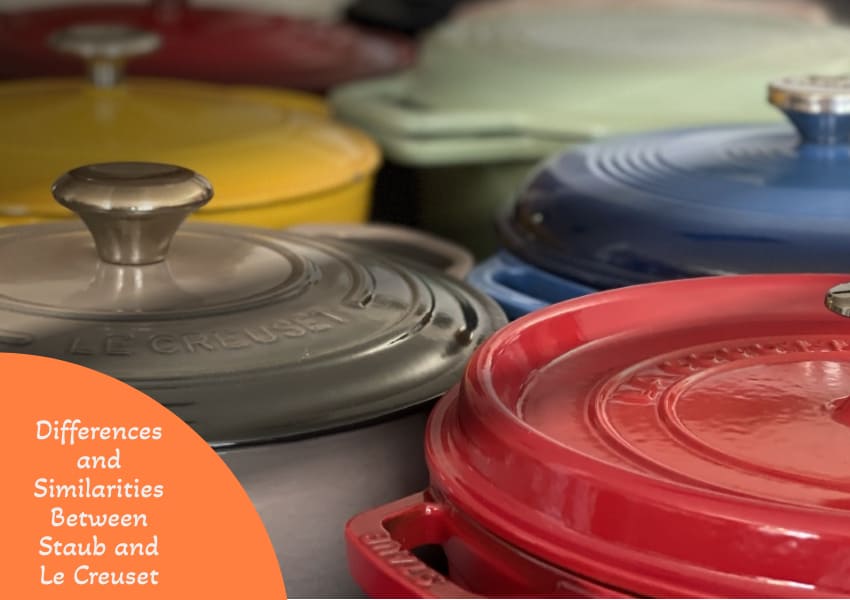
1. Color Differences
Both brands offer a wide range of color choices for their enamel pots.
- Staub colors like matte black, deep red, or graphite grey are dark and muted. Their palette is more subtle.
- Le Creuset opts for brighter, bolder hues like cherry, flame, or vibrant yellows and greens. Their colors make a statement.
The colors reflect each brand’s aesthetic. But performance is unchanged regardless of exterior paint.
- Interiors also differ. Staub interiors are black. Le Creuset has a light cream-coloured interior.
Dark interiors can make monitoring browning tricky. Light colors show food changes more clearly.
It comes down to personal preference. Choose whatever color suits your style, bold Le Creuset or understated Staub.
2. Lid Fit Differences
A tight-fitting lid is crucial for Dutch ovens to lock in moisture and flavor.
Both Staub and Le Creuset lids fit snugly onto the pot. The tapered design creates a tight seal.
- Le Creuset’s lids and pots align precisely, with a smooth, flat inner rim on the lid.
- Staub lids seal well, but the fit is not quite as seamless as Le Creuset due to Staub’s textured interior. This may allow slightly more moisture to escape during long braising with a Staub.
But both sufficiently seal in steam to create delicious dishes. The performance differences due to lid fit are marginal.
If you match the properly sized lid to the pot, either brand will hold aromas and flavors exceptionally well when cooking.
3. Knob and Handle Differences
The knobs and handles are two noticeable style differences between Staub and Le Creuset.
- Staub sticks with loop handles, similar to a cauldron. Le Creuset has larger, easier-to-grip handles.
The Staub loop handles have an old-world, traditional look. But they can be tricky for some to grasp. Le Creuset’s handles are ergonomic and comfortable. Great for oven use with an oven mitt.
- Staub knobs are plastic. Le Creuset uses cast iron knobs matching the pot color.
Both knobs provide a sturdy grip for lifting lids. Staub plastic won’t get as hot. But Le Creuset’s cast iron knobs match the high-end feel.
It’s personal preference. Those wanting modern comfort may prefer Le Creuset’s handles. Fans of vintage appeal may like Staub’s style.
Both provide the needed functionality. Pick what speaks most to your kitchen aesthetic.
4. Weight Differences
One noticeable difference is that Staub pans tend to be heavier than Le Creuset.
- Staub’s iron is slightly thicker, adding heft. Their lids also weigh more with the cast iron spikes.
- Le Creuset aims for a lighter product. Their pots range from 10-15% lighter than Staub equivalents.
The Staub weight lends a feeling of durability and heat retention. But Le Creuset offers ample toughness while being more accessible to lift.
This weight difference is modest. But it could factor in those unable to handle weighty pots. Le Creuset’s larger sizes exceed Staub’s max capacity while remaining lighter than Staub per quart.
If concerned about heaviness, Le Creuset may hold the edge. Otherwise, either brand has sufficient heft for heat distribution and cooking stability.
5. Shape Differences
The silhouette and proportions of Staub and Le Creuset pots have minor variations.
- Staub Dutch ovens have a very rounded, almost spherical shape. They maximize interior volume in a tighter circular footprint.
The Staub shape is focused on containing as much interior capacity as possible. Their sizes refer to quarts, not inches.
- Le Creuset opts for a slightly more oval, elliptical shape. This provides an additional flat surface for browning via the elongated base.
Le Creuset highlights the diameter. Their sizing refers to the pot’s width in inches.
These subtle shape differences do not impact performance. It comes down to aesthetic appeal. Staub’s sphere-like pots have old-world charm. Le Creuset’s oval has a more modern, sophisticated look.
Consider the shape and size labels that make the most sense for your cooking needs. Both deliver outstanding results.
6. Texture Differences
Inside the pots, Staub and Le Creuset have noticeably different surface textures.
- Staub interiors feature a rough, “grenadine” texture with visible grainy bumps.
The textured Staub surface is meant to emulate seasoned cast iron for improved browning. The texture provides visual appeal and may enhance sautéing.
- Le Creuset opts for an ultra-smooth interior enameled with a glassy feel.
Le Creuset’s smoothness makes cleaning easier and monitoring food simpler. It allows more direct heat transfer for efficient searing.
It’s about personal preference. Cooks wanting a cast iron-like finish may enjoy Staub’s textured interior. Those seeking an easy-clean smoothness will appreciate Le Creuset’s untextured cooking surface.
7. Size Differences
Both brands offer a range of Dutch oven sizes to suit different needs.
- Staub’s sizes go from 1.5 qt up to 7.25 qt. They focus on quarts to convey volume.
- Le Creuset offers sizes from 1.5 qt to a massive 13.25 qt model. They use diameter in inches.
Le Creuset’s larger options beat Staub’s maximum capacity of 7.25 quarts. But Staub offers more size choices in the 1.5-5.5-quart range. Le Creuset has fewer, bigger jumps between sizes.
Consider your typical cooking portions and needs. Larger families may want Le Creuset’s big 13 qt option. Smaller households may prefer Staub’s range of smaller, 2-3 qt sizes for meal prep.
You can always own multiple sizes. But Le Creuset excels for huge batches, while Staub offers more size fine-tuning.
8. Versatility Differences
Dutch ovens are prized for being highly versatile pans. Both Staub and Le Creuset offer outstanding flexibility.
- Their cast iron and enameled construction allow use on all cooktops – gas, electric, induction – and in the oven.
- Take them from stovetop simmering to oven braising seamlessly with the secure lid. Bake bread, roast meat, make stew – they do it all.
- Unlike bare cast iron, the enameled surface needs no extra seasoning, making clean-up easy.
- Use them for countless dishes – chilli, soups, braised short ribs, cobblers, and more. Replace several pans with one Dutch oven.
- While specialized for stews and braises, they also work for sautéing, frying, boiling, and roasting small items.
When it comes to versatility, Staub and Le Creuset are on par. Both are kitchen workhorses ready for nearly any recipe.
9. Durability Differences
When it comes to lasting performance, Staub and Le Creuset are equals. Both offer outstanding longevity.
- The thick cast iron ensures even heat distribution batch after batch, year after year. With care, they can serve meals for decades.
- The enamel coatings are chip and stain-resistant inside and out. They won’t interact with food. Clean-up is easy.
- Owners praise both brands for their ruggedness and reliability over time—many hands down their pots for the next generation to enjoy.
You can’t go wrong with Staub or Le Creuset for heirloom-level toughness. Both represent intelligent, long-term investments for your kitchen.
10. Heat Distribution Differences
Regarding heating food evenly, Staub and Le Creuset are equals. Both excel at distributing heat.
- The thick cast iron core conducts heat thoroughly and efficiently. It eliminates hot spots.
- Food cooks uniformly, whether simmering a sauce or baking bread. Meats braise to tender perfection.
- Cast iron requires preheating to prevent temperature drops when food is added. But once hot, it retains heat remarkably well.
- The enameled surface also distributes heat gently and smoothly across the bottom.
- Both brands create the ideal cooking environment, whether on the stovetop or in the oven.
You’ll achieve perfect results every time, thanks to the unparalleled heat properties of cast iron. Staub and Le Creuset are matched in performance for even heating and heat retention.
11. Heat Retention Differences
Cast iron is prized for its ability to retain heat beautifully. This allows Dutch ovens to keep food warm at the table.
- Thanks to their material, Staub and Le Creuset excel at maintaining temperature and heat.
- The thick, heavy cast iron stores heat energy. Once hot, it stays hot for an extended time.
- Le Creuset’s lighter weight means it may not retain as much heat as Staub over a long period. However, the differences are negligible for most uses. Both keep soups, stews, and more piping hot for hours when adequately preheated.
You can prepare a meal early; the cast iron will keep it ready to serve right on time.
Whether braising or taking a dish to a potluck, Staub and Le Creuset’s heat retention shine. Guests will enjoy comforting, warm meals.
12. Moisture Retention Differences
One key job of a Dutch oven is to retain moisture for tender, flavorful braises and stews. Staub and Le Creuset do this excellently, thanks to their tight-fitting lids and cast iron.
- Staub’s lid spikes catch and redistribute drippings back into the food. This self-basting can enhance moisture levels.
- Le Creuset’s flat lid relies more on a super tight seal with the pot rim to lock in steam.
Users report the Staub spikes leading to slightly more effective moisture return. But both brands retain moisture very well overall. The heavy cast iron also doesn’t let heat escape easily, keeping moisture from evaporating quickly.
You’ll achieve fork-tender roasts, fall-off-the-bone ribs, and robust stews in Staub and Le Creuset cookware. You can trust either brand to retain moisture beautifully for effortless braises and mouthwatering flavour.
13. Cleaning Differences
Caring for enameled cast iron requires some specific cleaning practices. But Staub and Le Creuset pots are similar in cleaning needs.
- Handwashing is recommended over dishwasher cleaning. The enamel can chip if banged around.
- Use mild soap and soft sponges. No abrasive scrubbers that can damage the finish.
- After washing, dry promptly and thoroughly. Allowing moisture to sit can lead to rust over time.
- Cooking oils can stain the enamel if not promptly cleaned. This may show more in Le Creuset’s light interiors.
- Neither surface needs extra seasoning like bare cast iron. The enamels provide natural, nonstick surfaces.
With proper washing by hand and thorough drying, both brands will clean up easily time after time. Take care of the enamel, and it will last for ages.
14. Manufacturing Differences
Staub and Le Creuset have long histories and pedigrees regarding Dutch oven production.
- Both companies were founded in France. Staub originated in Alsace in 1974. Le Creuset started in 1925 in Fresnoy-le-Grand.
- Today, most Le Creuset pieces are made in their foundry in Thailand. Some are still cast in France.
- Staub manufactures their cookware in factories in France and the USA. All enamelling takes place in France.
- The companies pride themselves on tradition and quality. They use proprietary recipes and techniques.
They control and oversee the entire process, from sourcing raw materials to finished products. Consumers can be confident they get an authentic product backed by generations of enamel-casting expertise. The French roots and high standards of each brand are evident in every Dutch oven.
15. Budget Differences
Dutch ovens from both premium brands represent an investment. But Staub and Le Creuset are comparable in price.
- Entry-level pieces start around $100-180 for smaller 1–3-quart sizes.
- Larger oven capacities range from $200-400, depending on features.
- Sale prices can offer significant discounts off retail prices.
- Le Creuset sometimes offers colorful special editions that cost more.
But in general, prices overlap across similar sizes or volumes. Cost differences are negligible. Budget-conscious buyers can take advantage of lower prices for undesirable colours.
With proper care, these pots will last decades. Their long lifespan helps justify the higher price.
For those seeking premium Dutch ovens, Staub and Le Creuset meet high standards without breaking the bank, especially when on sale.
16. Staub and Le Creuset Warranty
Staub and Le Creuset both provide strong warranties to back their premium cookware.
- Staub offers a limited lifetime warranty covering manufacturer defects for 3-10 years, depending on the region of purchase.
- Le Creuset tops this with an outstanding limited lifetime warranty covering defects for 10 years after purchase internationally.
Coverage includes replacement or repair for successfully verified defects or workmanship issues.
Normal wear and tear or damage caused by improper use aren’t covered. Accidents can void the warranty.
With proper care and maintenance, most owners enjoy their Dutch ovens for decades without issues. But Le Creuset’s longer 10-year warranty provides extra peace of mind for demanding users. Both stand behind their products very well.
Also read: Duo vs Duo Nova – Which Model Should You Buy?
Care And Maintenance Instructions for Staub and Le Creuset Dutch Ovens
Proper care is critical to preserving your investment in a Staub or Le Creuset Dutch oven. Fortunately, enamel cast iron is relatively low maintenance compared to bare cast iron.
- Gentle handwashing is best to avoid chipping enamel in a dishwasher. Use mild detergent and soft sponges.
- Dry thoroughly after washing. Allowing moisture to pool can damage the enamel over time.
- Avoid metal utensils to prevent scratching. Wooden or silicone tools are best.
- Don’t let oils sit too long before cleaning. This can lead to staining.
- Re-seasoning or extra oiling isn’t needed like with plain cast iron. The enamel provides natural nonstick.
Follow these habits, and your pot should last for generations. Treat it gently, and it will deliver decades of delicious meals.
For care, Staub and Le Creuset share the same requirements of mild hand washing and prompt drying.
Which Dutch Oven Is Right for You?
With outstanding reputations and premium materials, you can’t go wrong with either brand.
Consider your preferences for:
- Size – Le Creuset offers larger options
- Colors – Bold Le Creuset or muted Staub
- Shape – Staub rounder, Le Creuset more oval
- Lid style – Staub spike lids or flat Le Creuset
- Weight – Le Creuset slightly lighter
- Handles – Staub loop style or Le Creuset easy-grip
- Texture – Smooth Le Creuset or textured Staub
- Budget – Prices are comparable
Both deliver delicious results, easy care, and decades of service. Choose which best matches your cooking and style.
Consider collecting both! With proper use, these Dutch ovens will become treasured heirloom pieces for generations to enjoy.
Also read: Instant Pot vs Stovetop Pressure Cooker
Choosing The Right Dutch Oven
When shopping for a Staub or Le Creuset Dutch oven, keep these tips in mind:
- Consider your typical cooking batch sizes. Larger families may want 6+ quart capacities. Smaller households can use 4-5 quarts.
- Factor in the weight when full. Cast iron is heavy. Make sure you can safely lift and move the pot.
- Pick a size that has multiple uses. A 5-6 quart is versatile for recipes from soups to bread.
- Make sure the Dutch oven fits your stovetop burners and oven. Leave room for circulation.
- Choose a color you love since the pot will be on display in your kitchen often.
- Compare lid shapes and handle styles. Consider your usage, storage, comfort.
- Plan for future recipes and meal sizes. Having capacity to grow can be beneficial.
- Read reviews and look at options in person when possible. Quality and feel vary.
Spending a bit more for the right size and style is worth it for a lifetime of use. Don’t underestimate the convenience of having the perfect pot for preparing delicious one-pot meals for your household.
Pros And Cons of Staub and Le Creuset
Staub Pros And Cons:
- Matte black interiors great for browning
- Cast iron spike lids for moisture return
- High heat retention from thick construction
- Vintage design with loop handles
- Made in France and the USA
- Heavier than Le Creuset models
- Not as large of maximum size capacity
- Rough interior texture can require more cleaning
Le Creuset Pros And Cons:
- Light interiors make monitoring food easy
- Larger size options up to 13.25 quarts
- Smooth, easier to clean interior enamel
- Ergonomic handles provide a better grip
- Vibrant colors liven up any kitchen
- Slightly less heat retention due to lighter weight
- No spikes in lids to baste food
- Limited smaller size options
Both brands offer outstanding performance and quality. Choose which pros are most appealing to your needs.
Ideal Recipes of Staub and Le Creuset
Any braised dish or stew is perfect for enameled cast iron. The Dutch oven excel at:
- Beef bourguignon – The cast iron evenly browns the meat, then braises it for tenderness.
- Coq au vin – This French braise simulates chicken thighs in wine sauce.
- Beef stew – large batches are easy. The pot tenderizes meat and vegetables.
- Short ribs – Fall-off-the-bone ribs are easy with a long braise.
- Chili – Deep, hearty chili benefits from slow simmering.
- Pork shoulder – Shredding pork roast is effortless after low, slow cooking.
- Rustic bread – The pots retain heat for artisan loaf baking.
- Cobblers and crisps – Use the lid to steam fruit desserts gently.
The versatility also suits sautéing, simmering sauces, oatmeal, and more. Explore recipes from gourmet to homestyle comfort food. The Dutch oven brings out the best flavours.
Best Le Creuset and Staub Dutch Ovens
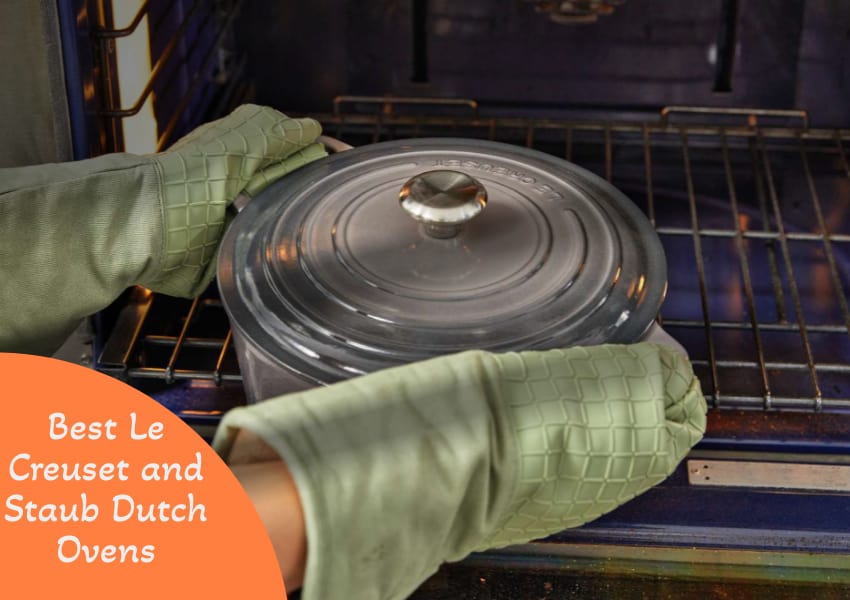
1. Le Creuset Enameled Cast Iron Signature Round Dutch Oven, 7.25 qt., Cerise
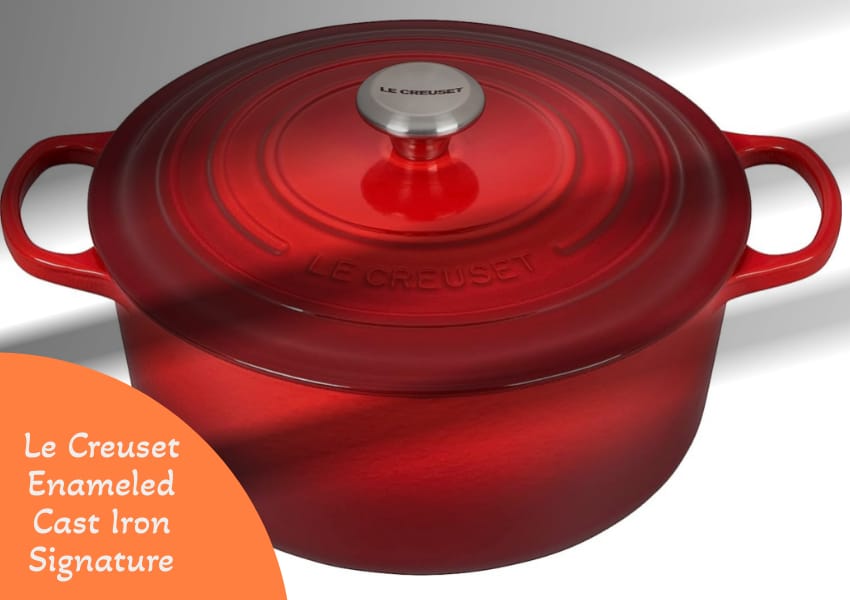
Le Creuset Enameled Cast Iron Signature Round Dutch Oven is the perfect size for all your cooking needs! This Dutch oven is a must-have addition to your kitchen arsenal.
It is made of enameled cast iron, which ensures superior heat distribution and retention. The durable enamel coating resists dulling, staining, chipping, and cracking, making it a long-lasting investment.
The light-colored smooth interior enamel allows you to monitor your cooking progress easily. At the same time, the tight-fitting lid circulates steam and returns moisture back to your food, resulting in deliciously tender and flavorful dishes.The ergonomic knobs and handles make lifting the dutch oven effortless and safe. Plus, the stainless steel knob is safe at any oven temperature.
- Excellent heat distribution and retention
- Versatile cooking vessel
- Easy to clean
- Durable and long-lasting
- Beautiful design and color options
- Suitable for a wide range of cooking techniques
- Compatible with all stovetops, including induction
- Available in various sizes and colours
- Seasoning is not required
- Expensive compared to other brands
- Can be heavy, especially when full
- Enamel coating may chip over time with rough handling or metal utensils
2. Staub Cast Iron 2.75-qt Round Cocotte – White Truffle
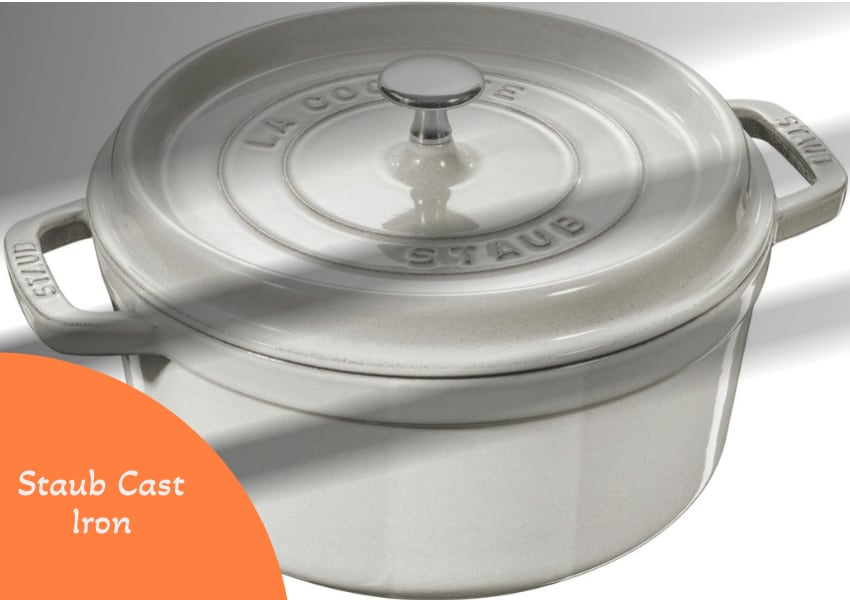
If you’re looking for a high-quality cast iron cocotte made in France, this 2.75-qt round cocotte in White Truffle is a great option. Crafted by STAUB, this cocotte offers both functionality and style.
The heavyweight and tight-fitting lid retains moisture, ensuring your dishes are moist and flavorful. The lid has spikes that create a rainforest effect, evenly returning juices onto your food for enhanced taste.
This cocotte is suitable for a wide range of cooking methods with an oven-safe capability of up to 900F/482C without the lid and 500F/260C with the lid. The smooth enamel bottom allows use on all stovetops, including gas, electric, glass, ceramic, induction, and halogen.
- Made in France with high-quality craftsmanship
- Retains moisture for flavorful dishes
- Evenly distributes heat for consistent cooking
- Suitable for various cooking methods and stovetops.
- Available in various sizes and colours
- It may be relatively expensive compared to other options
- It requires proper care and maintenance to prevent chipping or staining
FAQs
How do I know which size Dutch oven to get?
Consider what you typically cook – smaller sizes of 1-3 quarts are great for side dishes or cooking for 1-2 people. Larger 5-7 quart sizes are ideal for stews, chilli, braising meats, and cooking for more people.
Should I get a round or oval Dutch oven?
This is primarily an aesthetic choice, though oval provides a larger surface area for searing. Round Dutch ovens maximize interior volume. Both shapes perform equally well.
Can the enamel chip or crack over time?
Quality enamel is durable, but chips or cracks can happen if subjected to hard knocks, drops, or abrupt temperature changes. Avoid metal utensils scraping the enamel.
How do Staub and Le Creuset compare to cheaper Dutch oven options?
While more affordable Dutch ovens work well, Staub and Le Creuset stand out for heirloom-level quality and design that enhances cooking performance and longevity.
What colors fade the least over time?
Enamel color is cosmetic, but darker, muted colors like matte black or deep red tend to wear less than light or bright colors.
What recipes work best in a Dutch oven?
Braises, stews, soups, baked bread, and one-pot meals are perfect as the thick cast iron distributes and retains heat evenly. Dutch ovens excel at slow-cooked recipes.
Are Staub and Le Creuset Dutch ovens dishwasher safe?
No, both brands recommend handwashing to preserve the enameled surfaces. A dishwasher’s high heat and harsh detergents can damage the finish over time.
How heavy are these Dutch ovens?
Weights vary by size, but when full, expect 8-15 pounds or more. Handles let you move them when empty. But use pot holders when hot.
Can I use Staub or Le Creuset on induction cooktops?
The enameled cast iron works excellently with induction due to its magnetic properties. These pots are induction-ready.
How do I clean stuck-on food?
Soak in warm water, then use a non-abrasive sponge or soft cloth. Avoid harsh scouring pads. Burnt food may require special enamel cleaner.
What type of oil should I season with?
No pre-seasoning is needed with enameled cast iron. Simply cooking with oil over time will build up a natural patina.

